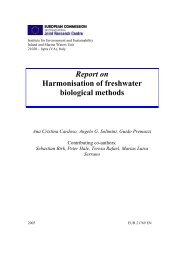Lakes and Watercourses
Lakes and Watercourses
Lakes and Watercourses
Create successful ePaper yourself
Turn your PDF publications into a flip-book with our unique Google optimized e-Paper software.
TABLE 9.<br />
DEVIATION from reference value, area-specific loss of total<br />
nitrogen in watercourses<br />
Class Description Recorded area-specific loss/reference value<br />
1 No or insignificant deviation ≤ 2.5<br />
2 Significant deviation 2.5 – 5<br />
3 Large deviation 5 – 20<br />
4 Very large deviation 20 – 60<br />
5 Extreme deviation > 60<br />
This classification is based on an overall assessment taking into account<br />
the area-specific losses occurring in Swedish watercourses affected by<br />
man to varying degrees. In some catchments, the ratio between recorded<br />
concentration <strong>and</strong> reference value may be less than 1, which may<br />
indicate a phosphorus deficit. Conditions of this kind should be particularly<br />
noted so as to allow further study of possible acidification-related<br />
effects. In some catchments, the ratio of recorded concentration to<br />
reference value for nitrogen may be less than 1, which may indicate a<br />
nitrogen deficit.<br />
Recorded area-specific loss refers to a mean figure for a 3-year period,<br />
calculated as shown above for classification of current conditions for<br />
area-specific losses.<br />
Reference values can be calculated or estimated in several ways. They<br />
may be estimated on the basis of historical studies of the area in question<br />
or studies of similar but unaffected watercourses in the vicinity. In the<br />
absence of other data, reference values can also be calculated using the<br />
characteristics of the catchment <strong>and</strong> other features of the watercourse.<br />
The equations specified in the previous Quality criteria for lakes <strong>and</strong><br />
watercourses (Swedish EPA 1991) can be used for this purpose, together<br />
with the additional equation shown below. All these relationships are<br />
expected to yield low estimates <strong>and</strong> the highest figure obtained using<br />
equations (1) – (5) <strong>and</strong> (6) – (10) should be used as the reference value.<br />
One exception is where the lake percentage is less than or equal to 2,<br />
where equations (2) <strong>and</strong> (7) should not be used.<br />
26















![Accommodation booking form [PDF]](https://img.yumpu.com/39471785/1/184x260/accommodation-booking-form-pdf.jpg?quality=85)

